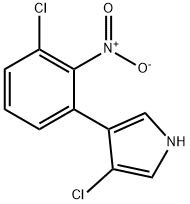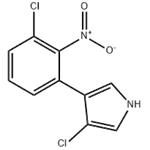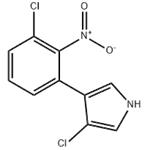Description
Pyrrolnitrin, isolated from Pseudomonas
species, is highly active against fungi,
particularly trichophyte species.
Uses
Pyrrolnitrin from
Pseudomonas cepacia has been used as a standard in the detection of pyrrolnitrin in
Serratia marcescens cell culture extract.
Definition
ChEBI: A member of the class of pyrroles carrying chloro and 3-chloro-2-nitrophenyl substituents at positions 3 and 4 respectively.
Origin
Pyrrolnitrin was found in the cells of Pseudomonas pyrrocinia grownin a medium containing a high concentration of inorganic phosphate.It was discovered by Arima of the University of Tokyo in collaboration with Fujisawa Pharmaceutical Industries Co. in 1965.
Biological Activity
Pyrrolnitrin shows strong activity against a variety of fungi and weak activity against grampositive bacteria.
Biochem/physiol Actions
Pyrrolnitrin blocks the terminal electron transport between succinate or reduced NADH and coenzyme Q. In mitochondria preparations of S. cerevisiae, the antibiotic inhibited succinate oxidase, NADH oxidase, succinate cythochrome C reductase, and NADH-cytochrome C reductase. Pyrrolnitrin is involved in many cellular processes such as oxidative stress, electron transport, DNA and RNA synthesis.



